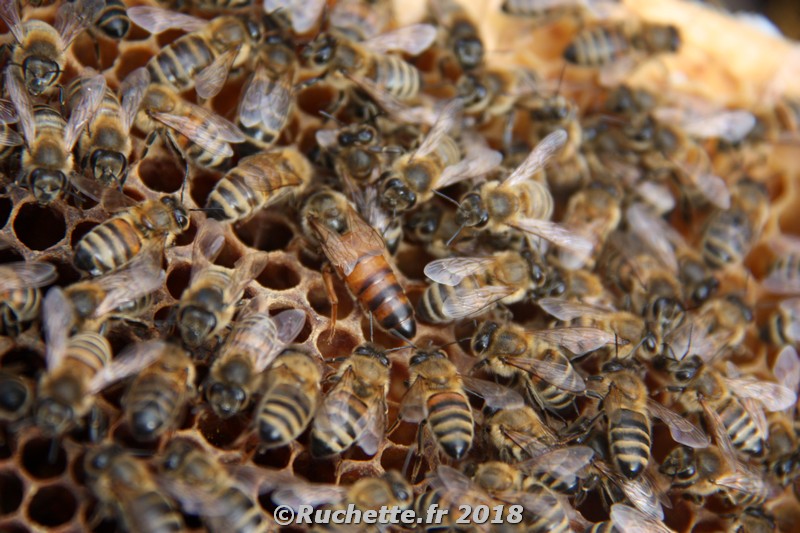The life of a honeybee colony
In the spring, a colony of bees will lodge itself cavity, a wall, a chimney, a hollow tree trunk or elsewhere dry and out of the wind.

Once installed, the colony will start to raise larvae and young bees and produce a surplus of honey that they store in preparation for the winter so as to ensure the survival of the colony.
Honeybees (apis mellifera) don’t hibernate in the winter, they stay warm by forming a cluster, eating honey to provide the energy they need to contract the muscles that they normally use to fly with. Their wings effectively dislocated, their contracting/de-contracting muscles generate heat that warms the cluster. The centre of the cluster where the queen can be found may reach temperatures of between 20 – 32 degrees C even in freezing conditions.
From springtime through the summer the colony grows becoming stronger. The queen lays eggs that become larvae, the worker bees feed the larvae royal jelly for a few days and then leave them to emerge a few weeks later also as worker bees.
When a combination of different factors converge, for example appropriate weather, the colony has reached a given size, nectar producing flowers are plentiful (plenty of pollen and nectar) etc. then the colony launches a process known as “swarming”.
Swarming is a process that in general consists of the separation of a colony into two groups. One group (known as the swarm) flies off with the queen to find a new home, leaving the remaining group in the hive to raise a new queen. In practice the raising of a new queen starts before the swarm flies off.
When swarming conditions are met the colony decides to swarm, this is the manner in which honeybees reproduce. The colony chooses a young larvae that they feed with a large quantity of royal jelly (all larvae are fed royal jelly, however for queen bees they a fed a much larger quantity). After a few days the cell containing the queen larvae is capped over with wax and the swarm leaves the hive with the old queen.
A few days later the new queen emerges from her cell and with the remaining bees they rebuild the colony.
The swarm (the group that left the hive) find a new abode and produce new wax honeycomb, the queen lays eggs in the cells in the comb that in turn become adult worker bees and a new colony is born! A good queen lays between 1500-3000 eggs per day at the peak of the season. Slowly but surely the colony grows. If the colony considers the old queen to be weak or unproductive then they will raise a new queen from one of her eggs/larvae. A productive queen in good health is a must if the colony is to survive.

Whilst a queen bee can can live anywhere from five to seven years her usefulness to the colony is limited to between two or three years before her capacity to lay eggs deteriorates.
Bee-keeing in relation to bees
We know that during a year the bees will reproduce, produce a surplus of honey and survive difficult winters. All of this on their own.
Bee-keeping, or to use the correct term, apiculture is nothing more than the acquired knowledge of the behavior, methods and reflexes of the bees, coupled with the exploitation of those reflexes (for example we may take a few frames from the brood nest of a strong colony to create a mini or nucleus colony that will raise its own queen, this is known as an artificial swarm) . However to succeed in bee-keeping and properly manage a hive or an apiary, the bee-keeper must also understand the seasons, local flora and fauna, and the weather.
Bee-keeping is a win-win activity for both the bee-keeper and the bees. The bee-keeper provides a warm and dry dwelling (a hive) for the bees, he or she preempts swarming by artificially dividing a colony (simulating swarming) and using the bees’ reflex to raise new queens and create new colonies. In return the bee-keeper may harvest the surplus of honey (for us to eat, but always ensuring that enough is left for the bees), propolis, and beeswax. If done properly and with respect for the bees and their needs then the bee-keeper becomes the guardian and guarantor of the sustainability of the both honeybee colonies and the environment.
